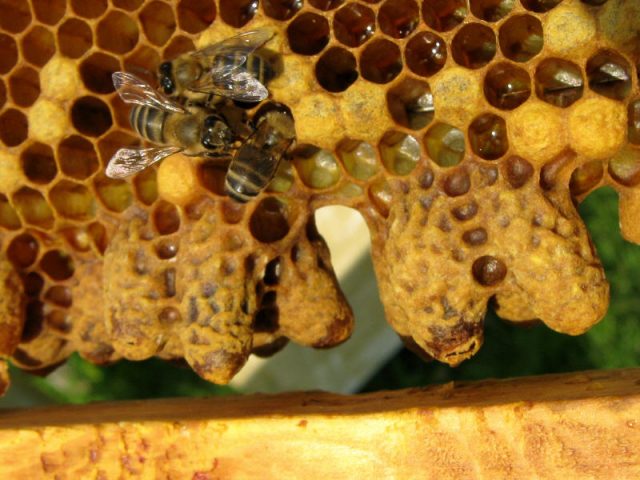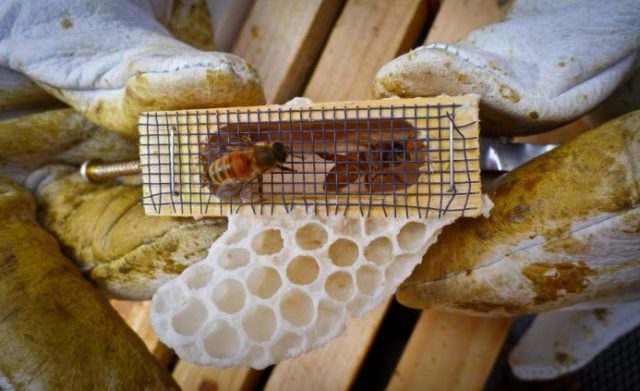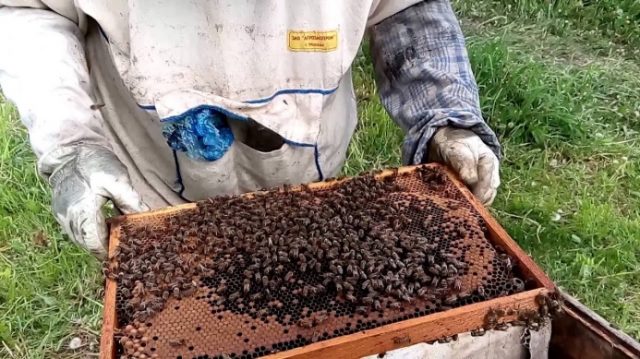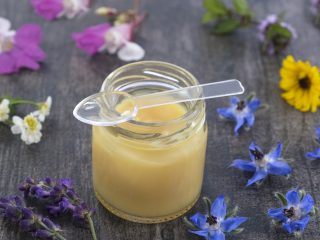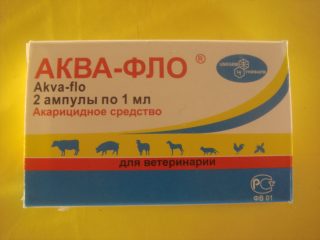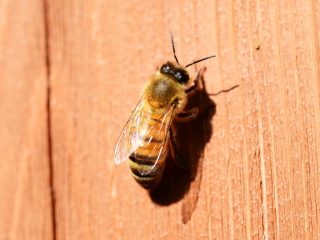Content
To make layering of bees in August, there are several methods: on a mature queen, on a fetal queen, on an infertile queen. Artificial mating of insects can be carried out during early spring and autumn. Reproduction helps to increase the number of insects and the amount of honey.
What is “layering” in beekeeping
Layers in beekeeping are a selection of individuals and brood for further artificial reproduction. There are three types of layering: young, old and uneven individuals. In each species, three subspecies are distinguished: for a fetal female, for an infertile female, for a mature mother. The mating of individuals by artificial means is resorted to to restore the swarm after the spring and autumn periods, to organize cores, for sale and increasing the number of individuals in the apiary.
When is it better to lay bees
Layering in the bee colony can be done with sufficient strength of the individuals, during the period when the drones appear, ready for mating, and always at an outside air temperature of at least 25 degrees. Laying bees can be carried out from early spring and finished in early August. If weather conditions permit, it can be carried out in the fall.
Layering is best done in the spring. The bees regain their strength during the winter and are ready to reproduce. In early spring, it is better not to do this, insects may not be strong enough, a decrease in the number of families is possible.
The formation of layering can be carried out in late summer and early autumn. With this option, insects need to be helped by substituting seeding at the exit. This can weaken the main families. The moment of breeding must be chosen so that the females begin to sow in them no later than a month and a half before the main bribe. Such small families will gain enough strength to work on honey collection.
How to lay down
Bee layering can be done in various ways. The most common ones are described below.
On the mother liquor
To do work on the mother liquor, you must first prepare small nuclei for mating queens. As soon as eggs begin to appear, colonies begin to strengthen with new queens.
Young individuals are perceived by the mother plant better than old ones, therefore it is recommended to make up the cores of young insects. For layering, 2-4 frames are taken from the main house and transferred to a new one. Additionally, take 2 more frames with honey. The new nest is insulated at the top and at the edges.
At sunset, when the flying bees leave their home, the queen bees are planted in the cage. Water is poured into the empty honeycomb. A day later, the mother liquor is released from the cage, until the moment of fertilization and egg laying, the swarm cannot be touched.
If the queen cell has not taken root, and the insects build fistulous queen cells, it is necessary to kill them and plant a new queen cell. Two weeks later, the result is checked again, if the mother is killed again, then the procedure is repeated. If eggs appear, then the mother liquor is not removed from the hive for another 2 weeks.
Reproduction is carried out a couple of months before the main collection of honey. After a successful brood, it is recommended to feed new individuals to strengthen the swarm. Under unsuitable weather conditions, the start of breeding may be delayed by a month.
On the fetal uterus
This is the easiest way to lay bees. The brood should be made large so that the queen can lay as many eggs as possible. In a small brood, the female may not lay enough eggs and a small generation of insects will grow.
The brood combs are transferred to a new equipped house together with the individuals. Several young insects are additionally placed there. They are taken from other broods in the main families. The honeycomb is moved along with honey and bee bread. They are placed on the sides of the brood in the new home.
For layering on the fetal uterus, in a new hive, it is necessary to have more than 4 kg of honey. For this amount, 1.5 kg of insects are taken. These are good conditions for fast breeding.
During the first days, the individuals do not leave the house; it is necessary to add water to the cells of the side combs by spraying.
When the bees begin to fly out of the hive, it is necessary, taking precautions, to release the queen from the cage. If after a couple of days weak reproduction is noticed, then it is recommended either to report several young individuals, or to remove one frame.
This method can be used 3 weeks before the start of honey collection. To prevent swarming, you need to choose for the family fertile females from the main family.
With a wintered core
You can reproduce with a wintering core. Nuclei are taken with additional females, which are well fed from the beginning of spring. To form a nucleus, it is provided with a sufficient amount of food, the nests are insulated. In such conditions, it grows rapidly. When the core is formed and matured, it is transplanted into a new hive. Later, it is strengthened by adding one brood frame, if all is well, then later you can add a few more frames.
Swarms can occur in this breeding method. This happens if there are too many young insects in the house and in the daytime the air temperature in the hive is high. In this case, the uterus simply cannot give offspring. To prevent this, the cores are periodically checked in a new hive. If swarming begins, they get rid of them.
On a young bee
Such layers can be formed from the same family or from different ones. They must be young, then there will be no enmity between them. You can use a fetal female, infertile or mature mother.
If reproduction is done from one family, then it is located next to the main hive. 2-3 frames with brood, 2 frames with bee bread are transferred into it. After 2–4 days, insects are shaken off from two more frames into the hive. Older individuals can return to their old home. This will make the new family weaker. At this moment, the female sits down. She is placed in an old hive in a cage in advance, and a barren one is placed in a cage in a new hive. If a mature mother plant is from the main hive, then it is placed immediately in a new house. After a few days, the cages are opened for mating. On the tenth day, the clutch should appear.
Layering by dividing the family into half a summer
For this method, the old hive is moved to a different location. In its place, a new house is being erected, with prepared frames. One-day sowing frames are transferred to a new home. Add frames with bee bread. The new hive will contain insects from old families. The next day, they check the number of individuals, if there are too many of them, some are removed, if not enough, then they are supplemented with frames with insects. The new hive is being insulated.
How to lay bees in the spring
To start work on the formation of layers, it is necessary to wait for the moment of awakening of insects after wintering. They need to get stronger. This usually happens when the outside temperature is kept at least 10 ° C. Weather conditions should be suitable: sufficient daylight hours and no threat of frost. There are two options for mating in spring:
- early... This method is used in early or mid-April. Doing it later will lead to swarming. The air should warm up to 20 degrees. It all depends on the region where the hive is located;
- late... During such a period, there is a high probability of non-return from the mating flight. If this happens, brood may not occur at all. This will lead to less honey. By the time of breeding, drones and queens should have time to form in families. The best time to spend is mid or late May.
To carry out layering in the spring you will need:
- Make a new bee hive.
- Nucleus, for each you need 2-3 frames. Nuclei are selected from young strong families.
- Mature mother liquor.
- The hive is insulated with foam or bunches of moss, reeds.
- Swarm, which will later be transferred to a new home.
- Female. It is chosen depending on the breeding method.
First you need to calculate and remove the uterus. You can take it from the main hive or buy it. Brood should be made from families that have begun to swarm. The honeycomb should be with eggs. To strengthen the new swarm, it is necessary to make top dressing with medicinal preparations, sugar syrup. Beech frames are prepared in advance. For one new house, 3-5 pieces are needed. An early flight of bees in the greenhouse can be carried out, this will allow identifying weak colonies and replacing unusable queens. If the female is purchased, then the layering is carried out 5-10 days later.
How to lay before swarming
Swarming bees yield less honey. Swarming begins in late April or early May. They rebuild the honeycomb with drone cells and begin the formation of drone brood. After a few days, queen cells appear. These are sure signs of the beginning of swarming. The insects form a swarm and leave their home. At this moment, you need to have time to catch insects in the swarm. Move them to a new hive. A new hive is put in place of the main one. When transferring individuals to a new home, it is necessary to remove the female. When the queen is lost, the bees stop swarming. In such a situation, there will be insects of different ages in the new house. Swarming of families is an instinctive reproduction of bees. This moment can be postponed, but cannot be prevented.
Is it possible to lay bees in August
Breeding is best done in springtime. On the days of August, bees are laid under suitable weather conditions. For this you will need:
- Make a new home for the bees.
- Several females from the main hive.
- 2-3 brood frames, it can be young or of different age.
- Frames with bee bread, 2-3 pieces for one family.
Before transferring individuals to a new house, you need to make insulation with foam or moss bunches. Layers of bees in August are carried out on a mother plant, a fertile or infertile female. After 4–5 days, you can check for eggs. If the laying was successful, then the bees need to be fed with sugar syrup. If there are no eggs, then they try to plant several new females. By the beginning of autumn, new families are formed.
How to make late layering bees in the fall
The best way to lay bees in the fall is the half-summer method. In autumn, reproduction is carried out at a sufficient temperature. If the weather conditions do not correspond, so as not to reduce the number of individuals and not to weaken the families, work is postponed to the spring. To carry out work in the fall, you need to make a new hive and insulate it well. Several young families are transferred to a new house, later a female is added. When masonry appears, insects need to be fed.
Conclusion
It is possible to lay bees in August and other times in several ways. Layering will help increase the number of bees in the apiary, make a second hive, and increase the amount of honey. To carry out such work, all the necessary conditions must be observed: the insects must be strong, healthy, the weather conditions must be suitable. Formation of new families is best done with young individuals, this will increase the likelihood of success.
